Impact of Resource Exploration on Climatic Change in Antarctic
Info: 9097 words (36 pages) Dissertation
Published: 4th Feb 2022
Tagged: Climate Change
Abstract
The progressive changes in the ice sheets are linked to the changes in climate change because of the underlying factor that control nature, heat. Heat is the bi-product of energy; however, if supplied at constant rate, creation and evolution would never have taken place. Diversity as presented remains a vital agenda. However, nature has its own means of controlling the use of energy, in particular, the controlling of the emission of CO2, which is a common waste of most living things. However, due to the increased consumption of one particular creature, human beings, there have been excess of hydrocarbons. These have ended up destroying the ozone layer, hence emitting significant amount of heat. Also, the report will be covering how the Sun heat relates with others. There are important graphs in the report clearing showing the interrelationship of human activities and the warming of Antarctica. The goal of the report is to show that we should care, as an abstract procedure of reverting the awaiting doom of Antarctica.
Table of Contents
Click to expand Table of Contents
1. Introduction
1.1 Background
2. Antarctica Ice, Lakes and Volcanism
2.1 Locality of Antarctica
2.2 How much exists
2.2.1 Lakes
2.2.2 Ice
2.2.3 Volcanoes
2.2.4 Other features
2.2 Who Controls the Resources?
3. Impacts
3.1 Drastic and Dangerous changes
3.2 Why is it important?
Figure 4: DJF
3.3 Inside Antarctica Impact
3.4 What is happening to our planet?
3.5 Why should we care?
3.5.1 inside Antarctica
3.5.2How these animals are affected
3.6 Outside Antarctica
3.6.1 Range Shifts
3.6.2 Migration
3.6.3 Ecological Issue
3.6.4 Impact on Human Beings
3.6.5 Reduced Fishing
3.6.6 Invasive species.
3.6.7 Tourism.
3.6.8 Pollution,
Chart 3: Changes of Global Carbon dioxide emissions
5.1 Environmental Analysis
4 What are the relationships?
4.1 Extinction Risks
4.2 Exploration and exploitation
4.3 Global Impacts
Chart 1: Global Green Gas Emission
4.4 Parasites
5. Conclusion
5.1 Recommendation
1. Introduction
Currently, there has been a centralized debate on the definitions of climate change. Climate change can be defined as the long lasting statistical distribution of weather patterns over a given period of time. According to Allgor (71)[1], Climate change is caused by biotic process and close variations in solar radiation tendencies received by plate tectonic and volcanic eruptions. The debate has focused keenly on the role played by human factors through industrializations and global warming tendencies. Human factors play a significant role since in their artificial contribution to natural process. In this case, human factors are a result of demands instigated by an expanded population which needs significant resources, natural and artificial for their sustenance. The study focuses on core human activities for instance, oil, coal, natural gas and other poisonous explorations, and how their exploration are causing distortions in the Antarctic. Other factors examined were global warming, global dimming, deforestation and global dimming in polluting colluding the environmental causing one, destruction of ozone layer, – a layer that regulate combustion between earth and the sun, and poisonous precipitation.
1.1 Background
Research has focused on the comparison of past, present and future climate change tendencies. Analysis generated from the research has often apprehended the geological evidence from borehole temperature profiles McMullen and Jabbour (29)[2] stated that there has been a significant removal of accumulation of ice and floral and faunal records. Other close analysis has examined “glacial and peri-glacial tendencies, stable isotope and the occurrence of sediment layers” (Gutt, 37)[3]. Recent data has examined in deep lengths on general circulation models of different categories of glacial development. The resultant process from this analysis have attempted to relate irregular global tendencies; for instance, the occurrence of ice melting, rising sea and ocean levels, reduction of snow caps in mountains, “prolonged draught spells and el-Niño rainfall as results of climate change. The term of climate change has evolved to a practical reference global warming. This description explains on the various changes affecting the South Pole continent of Antarctica.
Chart 1: Recent Sea Level Rise
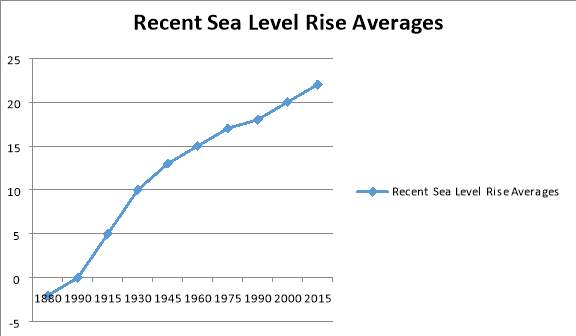
2. Antarctica Ice, Lakes and Volcanism
2.1 Locality of Antarctica
Antarctic lakes, ice and volcanoes are geographical regions found in the Antarctic continent located on the South Pole, which is directly opposite the North Pole arctic region. The continent comprises of the Antarctic plate which is a composition of ice shelves, island and waters. Before proceeding further, we note that Antarctic has a very severe and harsh environment, primarily because of its proximity on the globe as well as the number of tectonic plates. The Australian plate connects the region on the East, the Nazca plate on the West, the Pacific plate on the south, the African plate on the North, South American plate on the North West, while the Somali plate on North East[4]. Still on the North West, there are three baby plates, Scotia plate and, Sandwich plate and the Shetland plate[5]. Due to the intense collision of these plates, there has been intense volcanic activity. Hence, in Antarctic there are a range of volcanoes, and lakes covered which a dense ice sheet.
2.2 How much exists
Antarctica is the coldest, driest, and wildest, driest and windiest place on earth with ice covering 2,160 meters. Antarctica is close to 14 million square kilometers[6]. The ice sheet is close to 4,776 meters with a total percentage surrounding to almost 70 percent.
2.2.1 Lakes
There are several lakes in Antarctica, with largest lake being Lake Vostok covering an astonishing 6,058mi2. The other notable lakes include Lake Whillans and Lake Ellsworth. The total number of lakes is in hundreds however the exact number is yet to be established. Most of these lakes are tectonic lakes given that they naturally border Polar Regions of the properly compared and relatively young age for the most high latitude lakes.
2.2.2 Ice
According to multiple records by NASA, the new Antarctic ice records reflect on the possible complexity and diversity of the Earth environment. Although there were earlier claims that the Antarctic ice sheet was declining, NASA claims that the volume could be growing changing. Initially, in 1970s the total volume of ice has been declining by 28,800 square miles annually. In fact, since 1979, the Antarctic sea ice has exceeded by 7.72 million square kilometers. From 1981 to 2010, the average maximum has stood at 7.24 million square miles. As per Sept 22, 2016, the total Ice covered was 7.76 million presenting an increase from 1979 Antarctic ice extent for 7.72 million square miles[7].
Figure 1: Relationships of Ice and Land
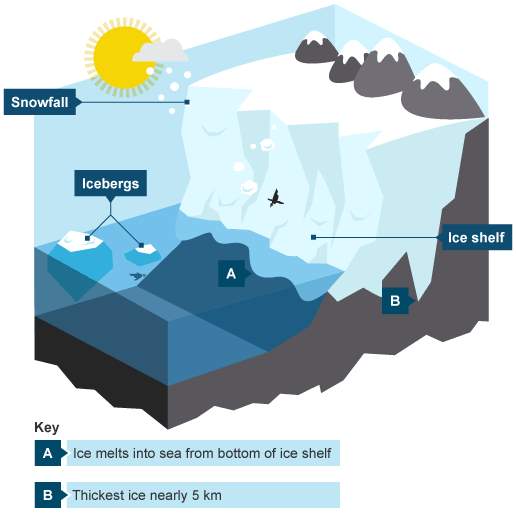
2.2.3 Volcanoes
Although ice has buried significant amount of volcano, molten rock is still erupting is still below the ice. The volcanoes existing beneath the ice through a giant amount of ice help in relating to the plate boundary of the rift landscape. The following is a list of volcanic mountains in Antarctica Mount Erebus, Mount Sidley, Peter Island, Mount Melbourne, Bridgeman Island, Mount Terror, and Toney Mountain.
2.2.4 Other features
The ice sheet is 90 percent of the World Ice. The Ice is divided into Transantractic Mountains, the EAIS covering the bigger percentage of the Eastern side and a smaller warmer WAIS covering much of the west. The EAIS receives 5 centimeters for water in a year. The Antarctica is the windiest places in the world with winds reaching to 50mph; the highest records are 200mph. The Transantarctic Mountains divides the continent into two, primarily the Antarctic Peninsula of the mountains. When the sun is the overhead the North, the Sea ice covers almost 10 feet in the continent creating a belt 300 to 900 miles. However, during the summer, the belt reduces 90 to 500 miles. The Trans-Antarctic mountain are placed across the continent The Antarctica peninsula has several mountains with the tallest being Vinson Massif standing at 16,066 feet above sea level.
Chart 1: Temperature Changes in the Peninsula
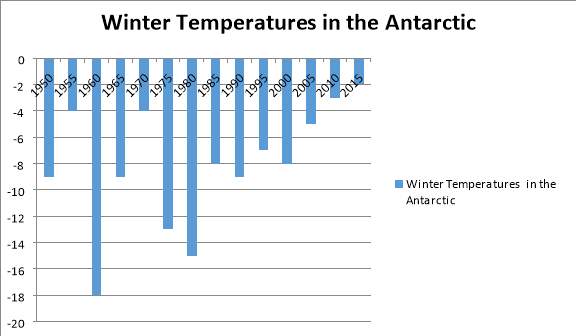
2.2 Who Controls the Resources?
Antarctica is currently been controlled by the joint treaty of Antarctica signed in 1959 by 12 members state who include Chile, Australia, New Zealand, Argentina, Norway and United Kingdom. However, the elective rights are distributed where some treaty claim that they can make a claim. However, the interests of each party are protected by Article IV of the Treaty. Under the treaty, the power constitutes the ability of asserting, denying, or making a claim to the territorial grounds and the sovereignty of Antarctica which creates a possible sovereignty in Antarctica[8]. The Antarctic Treaty puts aside the possible potential conflict for the sovereignty. The most important provisions of the treaty include, creating peaceful purposes for the first article. The second is creating freedom for investigation; the third treaty looks on the possible scientific observations, while the final promotes the objectives that ensure observations and governance of resources. The four treaties seek on looking for a lasting decision on the possible destructive effects based on the changes that Antarctica is causing.
3. Impacts
3.1 Drastic and Dangerous changes
In the past, present and likely in the future, there will be possible future changes of ice sheet. Antarctica was part of the Grand Godwana continent, a composition of the joined now South America, Africa, Middle East, Asia, Antarctica with Madagascar and Sri Lanka as Sandwich Island. The land was flourishing with ever rich biodiversity that is before the Ice Age[9]. However, the glacial periods began in Pleistocene Epoch. In the next 200 years, Antarctica became isolated to the very south and temperatures dropped significantly creating a large ice sheet. The glacial and interglacial cycles are primarily because of the emergence of various glacial phases. The warm and the cold oscillation are because of the changes in temperature primarily resulting in the reduction of ice. Currently, there lacks a perfect balance, that is during the winter there lacks a perfect accumulation as before, while during the summer, the ice melts at a much faster rate.
From the figure below, it is clear that the presence of warm colors indicates the possibly high concentration of 0-1 degrees. The Antarctic Peninsula creates a rift on the Western Ross Sea Region where very few grid points of the negative values that helps in identifying climatology progress. The statistics are calculated based on seasonal or annual means. The negative CE is the values on the Antarctic Peninsula Ronne Ice Shelf Region[10]. In Victoria Land for instance, the problem is the complex of the topography which is contributed to the radiosonde programming and the soviet station for the right consistency and the possible analysis. The topographic features are related to the lower skills for the reconstruction and the region.
The statistics are reflective to the independent observation placed within a grid point of reconstructions and reanalysis. The full-reconstruction statistics is with respect to the different observed and data and calibration period for the different temperature records that relate to the different data analysis.
3.2 Why is it important?
It is important to study the Antarctic climatic changes because there have been significant changes in the natural ecosystem. Western Peninsula and Northern peninsula Antarctic peninsula are the one of the fastest areas warming arm. The rising temperature is primarily responsible for a huge climate change impact which has resulted to a uniform influence on the ice extent. As a result, biodiversity and ecology have been heavily disrupted leading to a measurable influence on wildlife[11]. There are 5 major ice shelves. They include West Ice Shelf, Shackleton Ice Shelf, Ross Ice Shelf, Ronne Ice Shelf, and the now seemingly exiting Larsent B Ice Sheet. There have been findings indicating that the eastern peninsula has gained close to the 60 billion metric turns of ice per year. Given that inner Antarctic has been cooling to a greater precipitation which means that the area global warming trend predicts that warming is not parallel in all places. However, findings indicate that the extensive areas where snow melt is being felt are the west not the east.
In any case, the effect is widely distributed in the atmosphere. Drawing back from the problem of Antarctica, it is clear that the Western peninsula is receiving loss amounts of ice primarily because of its attitude. Looking carefully, there seem to be a major distinction between the EAIS and the WAIS. The western side of Antarctica seems to be experiencing a higher degree of warm sea waters, as they climb down the rift they become cool, finally condensing at the EAIS.
Key
Figure 1: The temperature of summer in Antarctica
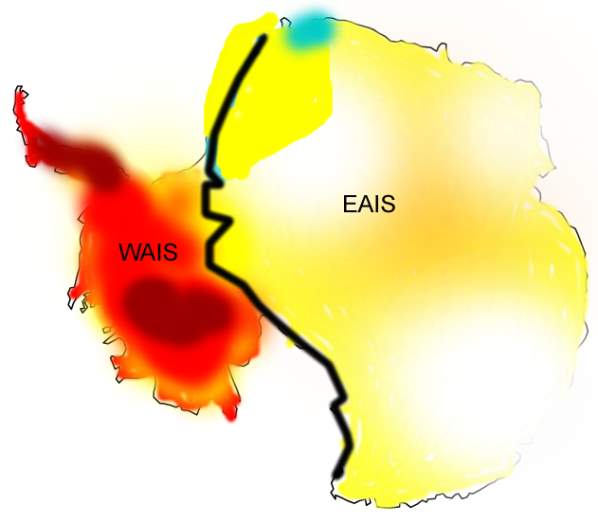
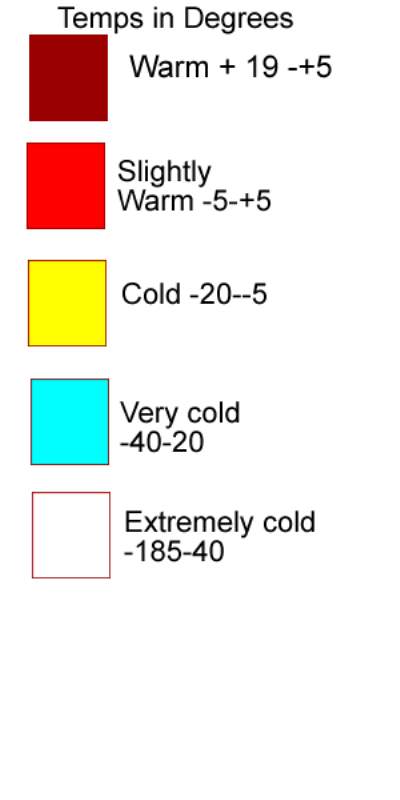
Figure 2: Antarctica without Ice
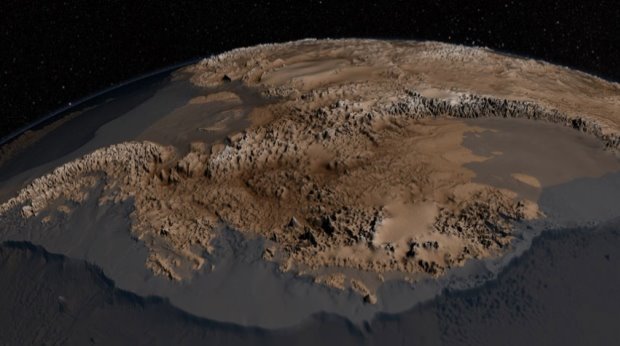
(Cbc, 2017)[12]
The photo above is a perfect example of how the Antarctica landscape looks if snow did not exists in the first place. It is also notable that there are a number of huge mountains at the edge of the western peninsula which is directly before the artists’ eye angle. From the figure 2.1 previous figures, it is clear that western peninsula will exhaust all its ice in a few decades primarily because of the sporadic temperature changes. Hence, based on our Heat Growth Theory established in this research, it can be proven that the eastern ice sheet will experience a much faster rate of loosing snow.
Heat Changes in Antarctica
Figure 1, explained the annual heating trends in the Antarctica, however, these trends are not constant and in most cases variations arises progressively. The heat statistics conducted below are explaining the changes in the four main seasons, Winter, Autumn, Sumner and Spring. However, in some cases, there are variations based on the lengths of days, the amount of rainfall and winds.
Figure 4: DJF
The picture below explains how winter used to be 100 years ago during the 1880s. During those times, winter lasted from April to Early September. The average temperatures are between 30 degrees Celsius. The nights are very long and day time short.
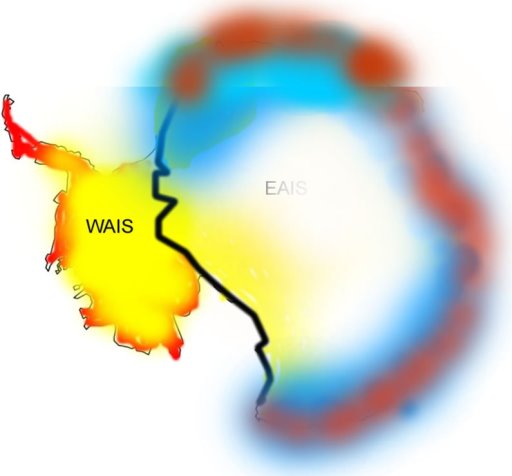
Figure 5: MAM
The second figure explains the present condition in Antarctica. The WAIS can be seen as warm as +15-+19 degrees celicus, while the EAIS seem to have warmed up during the last decade due to the changes of the climatic conditions.
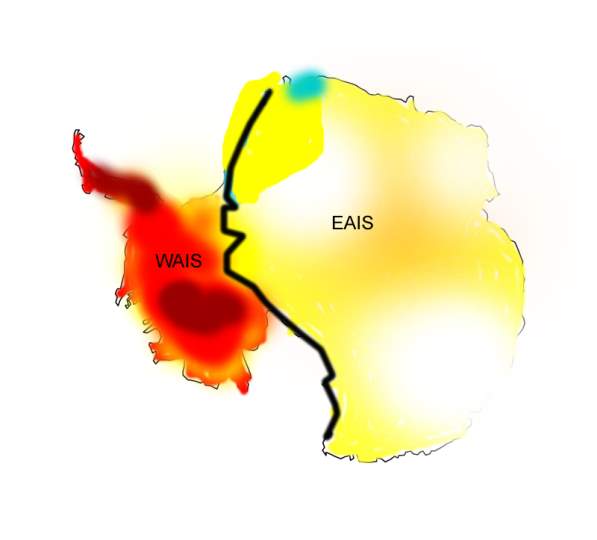
Figure 3:
Figure 3 explains the nature of winters in 1945 as you can see the WAIS has warmed up, as well the deadly zones in the EAIS have continuously changed progressively.
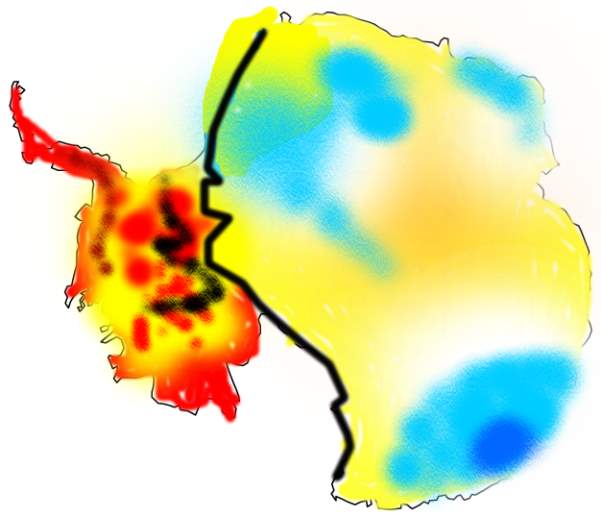
Figure 7: SON
The figure below explains the nature and climatic conditions of winter during the 1970s. As you can see some zones of the EAIS are still considerably cold with temperatures dropping to negative 30 degrees on usual days. The WAIS has considerably warmed up with time.
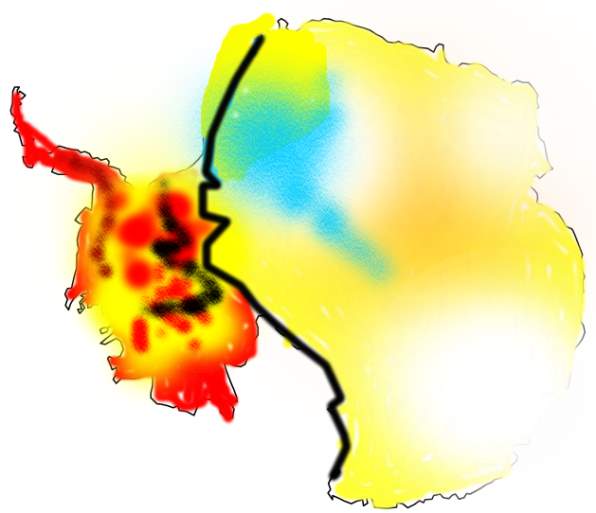
Figure 8: 1990s
The figure below explains the nature of changes in climatic conditions during the 80s and the early 90s. The white zones shows that at the moment some sections registered huge drops in temperatures.
3.3 Inside Antarctica Impact
It is necessary to establish the various determinants that have ground weather changes in Antarctica. In this case, the lucid identification of Antarctica geographical factors is a genuine concept (Okumura, 49). Firstly, the continent is affected with three different types of climates; these implying animals are affected differently, due to the various categories of climate change affecting Antarctica – see next discussion. Secondly, it is lucid to appreciate The figure below explores the annual and seasons temperature trends from 1959-2012. It is clear that that WAIS has been experiencing mild but consistent temperature changes with time. The darks red zones show the areas that have experienced the heaviest change. The largest peninsula in the continent is the East Antarctica Ice Sheet (EAIS)[13]. The region reaches a deep height of 4,000 meters and holds up to 60 meters of global sea level. In fact, this region has recorded the deepest Ice Drill in history implying it is actually the coldest region on earth, with the coldest temperature ever recorded at -89[14]. Ice sheets in this particular region are as result of growing showers during Snowfall and significant loss due to edge melting tendencies. The total change in Mass balance also implies a significant contribution to global climate factor due to the consideration of the aspect rising sea levels. Actually, EAIS is one of the red marked regions which can result to significant rising sea levels, and the direct implication of this means there are dire consequences affecting the west part where most animals reside along the ocean coast.
The Greenland – Sized west Antarctic Ice Sheet makes about twenty percent of total land mass of the Antarctic. This region stores at least six meters of global sea level, however, this region has significant contribution to the aspect of global warming and posing threat to its inhabitants (Okumura, 79). Firstly, WAIS is significantly lower than EAIS meaning, it is susceptible to the succession cyclones which transport moist warm water, implying that WAIS may become much warmer, therefore, posing a significant threat to its inhabitants. Again, another significant threat posed by global warming in consideration of WAIS, is the fact that WAIS ice sheets are below sea level[15]. This is potentially dangerous since ocean water conduct heat absorbed by increased sea temperatures. Unlike EAIS, WAIS glaciers are stored under the normal sea levels, implying increased melting will directly affecting Seals whose natural habitation is along ocean banks.
The Antarctic Peninsula is the finger which is viewed at the very north west of Antarctica. This region is about 4 percent of Antarctica but does not experience rapid climate change[16]. During summer, temperature often rich melting points, and in fact, the mountains spans have a resounding melting points, the glaciated mountains spine in northern Peninsula and the region is characterized with Alpine glaciers; however, while considering the general threat to inhabitants of this region, it is lucid to consider that global warming has caused a retreat of glaciers towards this region, in this case the region should be considered as a threat as well.
3.4 What is happening to our planet?
The above description for Antarctica is a perfect example that our planet is in a huge problem of global warming. Antarctica is just a starter example of what is happening globally concerning the problem of global warming. For many species, the climate where they live or spend part of the year influences key stages of their annual life cycle, such as migration, blooming, and reproduction. As winters have become shorter and milder, the timing of these events has changed in some parts of the country:
3.5 Why should we care?
We should care because Antarctica plays an important role in the global ecosystem, if Antarctica today losses its biodiversity a number of factors might end up influencing the region negatively. This section analyzes different animals in Antarctica. The continent and globe in general is inhabitant basically by all classes, mammals, birds, reptiles, and fish.
3.5.1 inside Antarctica
Common animals include Orcas which are Killer whales and live amid pack-ice areas of WAIS. Weddel Seal, found in southern parts of the Sea, they happen to be the most challenged animals in the continent[17]. Rockhopper Penguins these are penguins which stand between 16 to 18 inches tall and weigh around 6 pounds, they are estimated to be around 3.5 million in pairs[18]. Leopard seal, named for its similar colors with normal leopards. These animals are predators and often hunt Adelie Penguins for their survival. Unlike other seals the leopard seal uses its fore-flippers while swimming[19]. Another animal is the Black-browed Albatross; this animal can be distinguished from its distinctive of white head and neat black bow.
The animal weighs around 10 pounds and has a wingspan of up to eight feet. The blue whale, named for its blue gray color and it’s actually the largest animal on land, the animal can stretch up to 33 feet and weighs 120 tons[20]. The Adelie and the Emperor Penguines is the most unique animal on the continent , firstly, the male gather rocks to build the nests while female contest for the males[21]. The Crabeater seal, is the most agile of all seals and can dive up to 470 feet making a killing within minutes of departure, its favorite food is Antarctic Krils. The Arctic polar bear is one of the mammals residing in the continent; its primary source food is hunting. The Antarctic Shaq is a bad which is a predator fisher and catch through diving. The fur seal is the most aggressive seal amongst the seal families. Finally, the emperor penguin is the biggest of the 17 penguins’ species, they can way up to 100 pounds and they produce within the harsh Antarctic winter[22]. Other animals include Ross Seal, sea turtles, Chinstrap Penguin and Southern Elephant Seal, Wandering Albatross.
3.5.2 How these animals are affected
The necessity of knowing these animals is the required identification of how these animals depend on each other for a plethora of factors. Primarily, these animals either depend on each for food or deep on the environment. In either case, environmental degradation affects these animals in various categories.
3.6 Outside Antarctica
3.6.1 Range Shifts
North America temperature increases with the changes in habitual ranges. Over recent times, the changes in Western Peninsula of Antarctica have experienced changes in both land and aquatic environment which has been narrowed done to a range of expansion. This means that there is a close expansion for various species. The increased competition, range reduction and the species progress reflect on the northern limit that is suitable for the habitat. These factors lead to the development various extinction of both animals and plants that are results of ranges in the vegetative biomes that is projected to operate widely across the northern America.
3.6.2 Migration
Outside Antarctica there have been evidence indicating the possible migratory of close to almost 28 bird species of the United States. It is also clear that North eastern birds return to Southern United States, 2 weeks prior to how they used to do 100 years ago[23]. The species are only naturally reacting to the temperature changes that are a result of mismatches of migration, food availability and pest avoidance. Also, the migration changes with the changes in growth and survival mechanisms, primarily reproduction and food sources.
Besides, the globe has begun changing as waters around the Antarctica have been increasing. The regions are a perfect result of the changes of the ecosystems that present wide opportunities for hunting and fishing. However, the warm waters, has been alienating the coldwater fish which is a composition of salmon species who are greatly losing their habitat. If the current trends continue, the species will lose trout population that will be exceeding close to 60 percent.
3.6.3 Ecological Issue
Apart from food web disruptions, climate change[24] in Antarctica has gradually affected planet. The human caused issue will result to an imminent environmental issues resulting to a change in the primary habitat. Pellegrini argues that changes in Antarctica and the globe in general are a general result of the human related for the issues relating to the planet changes as well having a profound impact on the environment. By far large, the destruction of Antarctica results to the various conditions encouraging human beings and animals to seeks for alternative feeding grounds[25].
The wetlands provide possible essential breeding habitation areas for the most waterfowl species. Nonetheless, the permanently warmer provide drier future that leads to a threshold change dramatic dropping potholes which present waterfowl population while providing an essential breeding habitat permanently warmer, drier future which might lead to a possible threshold change based on the dramatic increase of waterfowl populations.
3.6.4 Impact on Human Beings
Changes in Antarctica lakes, ice, and volcanic activities have a profound impact on earth environment through the resultant human activities. In any case, the possible potential changes will have a profound impact on the earth for instance rising seas. The concerns and the environmental management present most reputable damage through which results to the changes and the future changes in environment.
3.6.5 Reduced Fishing
The world non fresh and fresh waters are experiencing overfishing. There are technologies already in place to see that they fish near the Antarctica as many fish species migrate to the Antarctica because of the large foods species. However, the changes in the environment around Antarctica means that food resource will be limited in the area.
3.6.6 Invasive species
The changes Antarctica climate results might to the emergence of new species types. These species might invade Antarctica in the near future. The consequence of global warming indicates that animals will be required to changing their breeding and feeding habits given that a new predator – human beings – will cause a huge impact on the environment.
3.6.7 Tourism
Changes in Antarctica will result to the disruption of the Antarctica ecosystems because humans’ beings will begin migrating to Antarctica to explore more opportunities for more resources. In their exploration, the pressure on the EAIS might increase leading to more ice melting. The process leads to the increase in sea level rises.
3.6.8 Pollution
Globally, especially in industrialized countries, Chlorofluorocarbon (CFC) has been in heavy production. The consequence of the ozone layer depletion as evidenced in the Antarctic is a clear that the entire globe is experiencing a major increase in heat. This brings a great loss on the birds, marine and fish mammals. The graph below shows the estimated CO2 emissions from the years 400,000 BC to present.
Chart 3: Changes of Global Carbon dioxide emissions
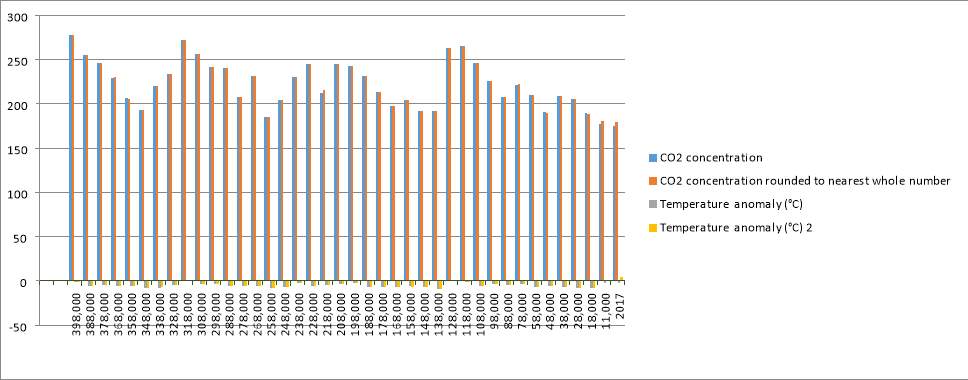
Environmental Analysis
Nestle strategic goals are to lead the Australian market, in relation confectionary industry. Besides, the company endeavors to provide competitive brands, based on lower cost products but increased quality on average.
4 What are the relationships?
4.1 Extinction Risks
There climatic changes lead to the destruction of the ecosystems and the possible the utterances of species breeding or feeding grounds, this is a perfect example of a major extinction event happening. Antarctica is a replica as well as the possible cause of the future extinction. The earth is currently experiencing the Holocene extinction event which began at the end of the last glacial period. The last major extinction event was the Cretaceous-Paleocene extinction event which happened 66 million years ago[26]. The extinction event wiped out most of the major species. Researchers affiliated to the University of California, have proved that Holocene epoch is occurring primary because of human activity (Ucmp, 2017). Unlike any other ever lived creature, human beings have influenced nature to abnormal conditions. The Holocene has resulted to the disappearance of the Megafauna. Most importantly, the human population growth in the last 12 thousand years has been a correlation between the extinction of the megafauna.
In particular, agriculture, mining and manufacturing have been directly responsible for the upward increase in environmental degradation. These are just a perfect example of natural competition that is embedded in the complex dynamics of life where there is a close relationship between population size and the possible territorial alterations. Clearly, the global rates of species extinctions are almost exceeding the natural rates because of the huge impact caused by the decline of breeding and feeding areas. The declining feeding grounds of the sea habitats in the Antarctica just indicate or signify the upcoming major extinction event.
4.2 Exploration and exploitation
Besides, the possible exploration and exploitation of oil, gas and other mineral reserves is primarily responsible in increase of nitrate in the air. The increase in exploitation of mining and manufacturing technologies leads to releases of these gases in the air. CFC is a bi-production of carbon[27] monoxide which a gas that results from the burning of different fuels in the air. Carbon monoxide is released when engines burn most fossil fuels. The emissions are higher when engines are not tuned to the proper composition. Nitrogen dioxide a dark or reddish brown gas is the product of burning fossil fuels. Most of it is emitted from plants and cars which is a direct result of air reacting to the high temperatures. Sulfuric dioxide is also another major production which results to the smelly low levels and rotten egg for high levels. Sulfur dioxide comes from burning oil and coal that process a number of chemicals. Lead is also produced in high quantities. Lead is highly toxic as well results to the contamination of the old pipes. The Antarctic Treaty recognizes the dangerous effect of these minerals leading to the exploitation.
4.3 Global Impacts
Antarctica changes are an important research question of global impacts of the industrialized world which leads to the changes of the maritime environment. The issue is emerging in Antarctica and is spreading gradually but meticulously across the globe. The Antarctic for instance the fastest development of regional climate which has not been found a other place on Earth. The average temperatures have rose by at least 0.9°C annually. Globally, the change might have a direct impact on the Antarctic environment for fauna and flora which resulted to the contribution of the breaking of ice shelves for the habitat. The abstract changes in Antarctic can therefore be used to reflect on the possible changes in the flora and the fauna globally. As illustrated, the flora and fauna have been the immediate culprits of the changes of the ice sheet. The figure below attempts to the compare the changes in global temperatures from 1880-2014.
Chart 3: Global Temperatures
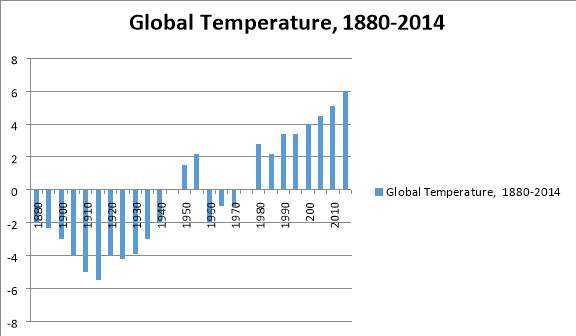
Climatologists assigned to the institute of O’Day, originally produced a chart comparing the differences between the annual mean and the baseline means of different anomalies (Shah, 2015). The chart shows the progress of global temperature based on the numerous NASA updates. The temperature anomalies provide the right consistency of the negative anomalies which record a global temperature if warmed. It is clear that 1880-1937, the temperature was below 0. However, an interesting finding have been registered from 1939-1945. This was because of the negative impact of World War II. During this time, there were more toxic reactions released from a number of deadly weapons. Soon after world war, the next 5 years were characterized with below 0 degrees. The base period of 1950-1980, was the genesis of industrialization. From 1980-to the current time, the temperature has been increasing primarily because of the increase greenhouse emissions, a fact that has been parallel to the changes in the Antarctica.
Chart 1: Global Green Gas Emission

The following data was generated from the intergovernmental panel on Climate Change. The data was part of the intergovernmental panel on Climate Change which was based on the Second Assessment Report (SAR). The data shows how methane, hydrocarbons and nitrates lead in the overall gas emissions. There were three assessment conducted. Each of the assessment reflected diverse reasons[28]. The three assessment indicated taht HFC-23 Trifluoremethane and Perfluromethane, and Perfluroethane as the leading gas emissions. Also, Perfluoropentane and Perflurobutate reflected an increase in the overall emissions. Another included perfluorohexane and HFC were still the major emissions. In this case, each of these performances ranged differently from the various assessments.
4.4 Parasites
Climate changes in Antarctica disturb the perfect ecological [29] conditions that support the normal ecological precision. As a result, the flora and the fauna are directly affected by the possible parasites, diseases and other potentially serious effects on agriculture, human health and fisheries. These effects lead to the extension of parasitic that result to the expansion of the winter conditions that are affecting to the average winter temperature. The climatic change on agriculture lead to the huge changes in the supply chain impacts as well as have a profound impact on human health.
5. Conclusion
Antarctica is a vital area in the face of the planet, and human should consider protecting its natural habitat and not destroying. This document has established how Antarctic animals are severely affected by rapid changes in climate changes. In particular, the document has examined rising temperature and the ice breaking mechanism as direct consequences which institutionalize challenges on aggregate. The document has inversely appointed food and animal conflict factors as the direct impacts of climate change amid other factors. The document has terminated with lucid recommendation on possible schemes to manage climate change.
5.1 Recommendation
Although efforts by the five treaty members have made tremendous efforts in curtailing climate change, the Antarctic problem is still a major global problem. On improvising possible recommendations, defenders are often basing on research and the best science to understand the full impacts of climate change. The important aspect here is conversation[30]. This can be arrived at the collective solutions through instigation of laws, and policies of funding strategies and guidelines. The Antarctic treaty should be put in close focus with the inherent consideration of global interest against natural interests. To generate immediate and quick solutions to the problem, there should be follow up to policies and laws instituted on the land. Firstly, adaption of common principles is necessary. This will ensure that there is close focus on replacing destructive trends with constructive trends. Basic principles include, avoid usage; for instance, plastic – national policy. Seek of alternative energy solution over the traditional oil hegemony. Proposal can focus on usage of ethanol from plants or hydroelectric power.
Works Cited
Ainley, David G., Grant Ballard, and Silvia Olmastroni. “An Apparent Decrease In The Prevalence Of “Ross Sea Killer Whales” In The Southern Ross Sea”. N.p., 2017. Web Accessed 30 Mar. 2017 http://dx.doi.org/10.1578/am.35.3.2009.334
Allaboutbirds,. “The Basics Of Bird Migration: How, Why, And Where”. All About Birds. N.p., 2007. Accessed 29 March 2017, from https://www.allaboutbirds.org/the-basics-how-why-and-where-of-bird-migration/
Allgor, Marie. Endangered Animals of Antarctica and the Arctic. New York: The Rosen Publishing Group, 2011, Print.
BARNES, D. K. A., L. S. PECK, and S. A. MORLEY. “Ecological Relevance Of Laboratory Determined Temperature Limits: Colonization Potential, Biogeography And Resilience Of Antarctic Invertebrates To Environmental Change”. Global Change Biology.. N.p., 2010. Accessed 30 Mar. 2017 http://dx.doi.org/10.1111/j.1365-2486.2010.02176.x
Bbc.co.uk,. “BBC – KS3 Bitesize Geography – Antarctica : Revision, Page 3”. Bbc.co.uk. N.p., 2016. Web. 30 Mar. 2017. Accessed 30 Mar. 2017 http://www.bbc.co.uk/bitesize/ks3/geography/places/antarctica/revision/3/
Britannica.com,. “K-T Extinction”. Encyclopedia Britannica. N.p., 2016. Web. 29 Mar. 2017. https://www.britannica.com/science/K-T-extinction
Cbc.ca,. “NASA Map Shows What Antarctica Would Look Like Without Ice”. CBC News. N.p., 2017. Web. 30 Mar. 2017. Accessed 30 Mar. 2017 http://www.cbc.ca/news/technology/nasa-map-shows-what-antarctica-would-look-like-without-ice-1.1304997
Dalby, Simon. “Book Review: Geopolitics In Antarctica: Views From The Southern Oceanic Rim”. Progress in Human Geography 23.2 (1999): 308-309. Accessed 30 Mar. 2017 Web. http://dx.doi.org/10.1177/030913259902300218
Darelius, E., I. Fer, and K. W. Nicholls. “Observed Vulnerability Of Filchner-Ronne Ice Shelf To Wind-Driven Inflow Of Warm Deep Water”. N.p., 2017. Accessed 30 Mar. 2017
Dessi-Fulgheri, Francesco. “Antarctic Ecosystems: An Extreme Environment In A Changing World.”. Ethology Ecology & Evolution 27.3 (2015): 335-344. Web.
Extremescience.com,. “Plate Tectonics | Plate Boundaries”. Extremescience.com. N.p., 2017. Web. 30 Mar. 2017. Melbourne-Thomas, Jessica et al. “Testing Paradigms Of Ecosystem Change Under Climate Warming In Antarctica”. PLoS ONE 8.2 (2013): e55093. Web.
FORCADA, JAUME, and PHILIP N. TRATHAN. “Penguin Responses To Climate Change In The Southern Ocean”. Global Change Biology 15.7 (2009): 1618-1630. Web. . http://dx.doi.org/10.1111/j.1365-2486.2009.01909.x
Global-warming-and-the-climate.com,. “The Causes Of Global Warming And Climate Change!. Global-Warming-And-The-Climate.Com”. Global-warming-and-the-climate.com. N.p., 2017. Accessed 28 March 2017, from http://www.global-warming-and-the-climate.com/
Grimston, Malcolm. “Sustainable Development And Nuclear Power”. Energy & Environment 17.2 (2006): 181-190. Accessed 28 March 2017, from http://dx.doi.org/10.1260/095830506777070150
Gutt, Julian et al. “Shifts In Antarctic Megabenthic Structure After Ice-Shelf Disintegration In The Larsen Area East Of The Antarctic Peninsula”. Polar Biology 36.6 (2013): 895-906. Web. http://dx.doi.org/10.1007/s00300-013-1315-7
Hemmings, Alan., Rothwell, Donald., &Scott, Karen. Antarctic Security in the Twenty-First Century: Legal and Policy Perspectives. New York: Routledge, 27 Nov. 2012. Web. https://www.routledge.com/Antarctic-Security-in-the-Twenty-First-Century-Legal-and-Policy-Perspectives/Hemmings-Rothwell-Scott/p/book/9780415620253
Howe, Carol. Smith, Joel. Henderson, Jim. Climate Change and Water: International Perspectives on Mitigation and Adaptation. New York: IWA Publishing, Print. 2010.
Jenouvrier, Stéphanie et al. “Effects Of Climate Change On An Emperor Penguin Population: Analysis Of Coupled Demographic And Climate Models”. Global Change Biology 18.9 (2012): 2756-2770. Accessed 28 March 2017, from http://dx.doi.org/10.1111/j.1365-2486.2012.02744.x
Jones, A. “NASA : Antarctica Is Cooling And Heating At The Same Time”. Real Science. N.p., 2017. Accessed 28 March 2017, from https://stevengoddard.wordpress.com/2013/01/08/nasa-antarctica-is-cooling-and-heating-at-the-same-time/
Kejna, Marek, Andrzej Araźny, and Ireneusz Sobota. “Climatic Change On King George Island In The Years 1948–2011”. Polish Polar Research 34.2 (2013): Accessed 28 March 2017, from http://dx.doi.org/10.2478/popore-2013-0004
McMullen, Catherine., & Jabbour, Jason. Climate Change Science Compendium 2009. Nairobi:
Melbourne-Thomas, Jessica et al. “Testing Paradigms Of Ecosystem Change Under Climate Warming In Antarctica”. PLoS ONE 8.2 (2013): e55093. http://dx.doi.org/10.1371/journal.pone.0055093
Misra, Anil Kumar. “Climate Change Impact, Mitigation And Adaptation Strategies For Agricultural And Water Resources, In Ganga Plain (India)”. Mitigation and Adaptation Strategies for Global Change 18.5 (2012): 673-689. http://dx.doi.org/10.1007/s11027-012-9381-7
Okumura, Yuko M. et al. “Decadal–Interdecadal Climate Variability Over Antarctica And Linkages To The Tropics: Analysis Of Ice Core, Instrumental, And Tropical Proxy Data”. Journal of Climate Change. N.p., 2017. http://dx.doi.org/10.1175/jcli-d-12-00050.1.
Pellegrini, Lorenzo. “Assessing The State Of The World: Environment And Development”. Development and Change 38.6 (2007): 1245-1254. http://dx.doi.org/10.1111/j.1467-7660.2007.00453.x
Quartino, María Liliana et al. “Evidence Of Macroalgal Colonization On Newly Ice-Free Areas Following Glacial Retreat In Potter Cove (South Shetland Islands), Antarctica”. PLoS ONE 8.3 (2013): e58223. http://dx.doi.org/10.1371/journal.pone.0058223
Riley, P. et al. “Global Warming: Chinese Narratives Of The Future”. Global Media and China 1.1-2 (2016): 12-31. http://dx.doi.org/10.1177/2059436416654770
Shah, Anup. “Climate Change And Global Warming Introduction — Global Issues”. Globalissues.org. N.p., 2015. Accessed 29 Mar. 2017 http://www.globalissues.org/article/233/climate-change-and-global-warming-introduction
Stephens, Tim. “Antarctic Security In The Twenty-First Century: Legal And Policy Perspectives”. The Polar Journal 2.2 (2012): 464-466. Web. http://dx.doi.org/10.1080/2154896x.2012.735444
Stringer, Lindsay C. “Africa: Atlas Of Our Changing Environment, United Nations Environment Programme (UNEP). UNEP, Nairobi, 2008. ISBN: 9789280728712, Xviii + 374 Pp”. Land Degradation & Development 20.3 (2009): 351-352. Web. . http://dx.doi.org/10.1002/ldr.892
Ucmp,. “The Holocene Epoch”. Ucmp.berkeley.edu. N.p., 2017. Web. 29 Mar. 2017. http://www.ucmp.berkeley.edu/quaternary/holocene.php
UNEP/Earthprint, 2009. Print.
Usatoday,. “USATODAY.Com – Physical Facts About Antarctica”. Usatoday30.usatoday.com. N.p., 2017. Web. 30 Mar. 2017. http://usatoday30.usatoday.com/weather/resources/coldscience/ageog.htm
[1] Allgor, Marie. “Endangered Animals of Antarctica and the Arctic. New York: The Rosen Publishing Group, 2011, Print.
[2] McMullen, Catherine., & Jabbour, Jason. Climate Change Science Compendium 2009. Nairobi: UNEP/Earthprint, 2009. Print.
[3] Julian Gutt et al., “Shifts In Antarctic Megabenthic Structure After Ice-Shelf Disintegration In The Larsen Area East Of The Antarctic Peninsula”, Polar Biology 36, no. 6 (2013): 895-906.
[4] Extremescience.com, “Plate Tectonics | Plate Boundaries”, Extremescience.Com, last modified 2017, accessed March 30, 2017, http://www.extremescience.com/plate-boundaries.htm.
[6] Usatoday, “USATODAY.Com – Physical Facts About Antarctica”, Usatoday30.Usatoday.Com, last modified 2017, accessed March 30, 2017, http://usatoday30.usatoday.com/weather/resources/coldscience/ageog.htm.
[7] NASA, “Antarctic Sea Ice Reaches New Record Maximum”, NASA, last modified 2017, accessed March 30, 2017, https://www.nasa.gov/content/goddard/antarctic-sea-ice-reaches-new-record-maximum/.
[8] Simon Dalby, “Book Review: Geopolitics In Antarctica: Views From The Southern Oceanic Rim”, Progress in Human Geography 23, no. 2 (1999): 308-309.
[9] Usatoday, “USATODAY.Com – Physical Facts About Antarctica”, Usatoday30.Usatoday.Com, last modified 2017, accessed March 30, 2017, http://usatoday30.usatoday.com/weather/resources/coldscience/ageog.htm.
[10] E. Darelius, I. Fer and K. W. Nicholls, “Observed Vulnerability Of Filchner-Ronne Ice Shelf To Wind-Driven Inflow Of Warm Deep Water”.
[11] Francesco Dessi-Fulgheri, “Antarctic Ecosystems: An Extreme Environment In A Changing World.”, Ethology Ecology & Evolution 27, no. 3 (2015): 335-344.
[12] Cbc.ca, “NASA Map Shows What Antarctica Would Look Like Without Ice”, CBC News, last modified 2017, accessed March 30, 2017, http://www.cbc.ca/news/technology/nasa-map-shows-what-antarctica-would-look-like-without-ice-1.1304997.
[13] Julian Gutt et al., “Shifts In Antarctic Megabenthic Structure After Ice-Shelf Disintegration In The Larsen Area East Of The Antarctic Peninsula”, Polar Biology 36, no. 6 (2013): 895-906.
[14] Bbc.co.uk, “BBC – KS3 Bitesize Geography – Antarctica : Revision, Page 3”, Bbc.Co.Uk, last modified 2016, accessed March 30, 2017, http://www.bbc.co.uk/bitesize/ks3/geography/places/antarctica/revision/3/.
[15] Julian Gutt et al., “Shifts In Antarctic Megabenthic Structure After Ice-Shelf Disintegration In The Larsen Area East Of The Antarctic Peninsula”, Polar Biology 36, no. 6 (2013): 895-906.
[16] Howe, Carol. “Smith, Joel. Henderson, Jim. Climate Change and Water: International Perspectives on Mitigation and Adaptation”. New York: IWA Publishing, 2010.
[17] D. K. A. BARNES, L. S. PECK and S. A. MORLEY, “Ecological Relevance Of Laboratory Determined Temperature Limits: Colonization Potential, Biogeography And Resilience Of Antarctic Invertebrates To Environmental Change”, Global Change Biology.
[18] JAUME FORCADA and PHILIP N. TRATHAN, “Penguin Responses To Climate Change In The Southern Ocean”, Global Change Biology 15, no. 7 (2009): 1618-1630.
[19] Stéphanie Jenouvrier et al., “Effects Of Climate Change On An Emperor Penguin Population: Analysis Of Coupled Demographic And Climate Models”, Global Change Biology 18, no. 9 (2012): 2756-2770.
[20] David G. Ainley, Grant Ballard and Silvia Olmastroni, “An Apparent Decrease In The Prevalence Of “Ross Sea Killer Whales” In The Southern Ross Sea”.
[21] Stéphanie Jenouvrier et al., “Effects Of Climate Change On An Emperor Penguin Population: Analysis Of Coupled Demographic And Climate Models”, Global Change Biology 18, no. 9 (2012): 2756-2770.
[22] David G. Ainley, Grant Ballard and Silvia Olmastroni, “An Apparent Decrease In The Prevalence Of “Ross Sea Killer Whales” In The Southern Ross Sea”.
[23] Allaboutbirds, “The Basics Of Bird Migration: How, Why, And Where”, All About Birds, last modified 2007, accessed March 29, 2017, https://www.allaboutbirds.org/the-basics-how-why-and-where-of-bird-migration/.
[24] Marek Kejna, Andrzej Araźny and Ireneusz Sobota, “Climatic Change On King George Island In The Years 1948–2011”, Polish Polar Research 34, no. 2 (2013).
[25] Francesco Dessi-Fulgheri, “Antarctic Ecosystems: An Extreme Environment In A Changing World.”, Ethology Ecology & Evolution 27, no. 3 (2015): 335-344.
[26] Britannica.com, “K-T Extinction”, Encyclopedia Britannica, last modified 2016, accessed March 29, 2017, https://www.britannica.com/science/K-T-extinction.
[27] Global-warming-and-the-climate.com, “The Causes Of Global Warming And Climate Change!. Global-Warming-And-The-Climate.Com”, Global-Warming-And-The-Climate.Com, last modified 2017, accessed March 30, 2017, http://www.global-warming-and-the-climate.com/.
[28] Malcolm Grimston, “Sustainable Development And Nuclear Power”, Energy & Environment 17, no. 2 (2006): 181-190.
[29] Francesco Dessi-Fulgheri, “Antarctic Ecosystems: An Extreme Environment In A Changing World.”, Ethology Ecology & Evolution 27, no. 3 (2015): 335-344.
[30] Hemmings, Alan., Rothwell, Donald., &Scott, Karen., “Antarctic Security in the Twenty-First Century: Legal and Policy Perspectives”. New York: Routledge, 27 Nov. (2012).
Cite This Work
To export a reference to this article please select a referencing stye below:
Related Services
View allRelated Content
All TagsContent relating to: "Climate Change"
Climate change describes large changes in global or local weather patterns and global warming generally considered to be largely caused by an international increase in the use of fossil fuels from the mid-20th century onwards.
Related Articles
DMCA / Removal Request
If you are the original writer of this dissertation and no longer wish to have your work published on the UKDiss.com website then please:





